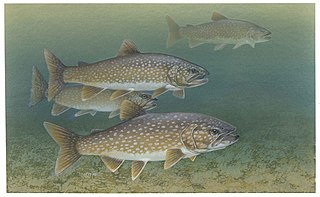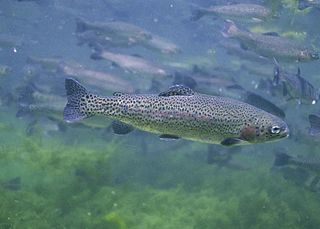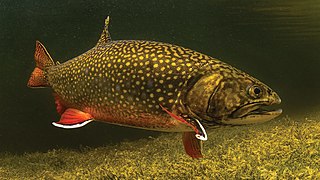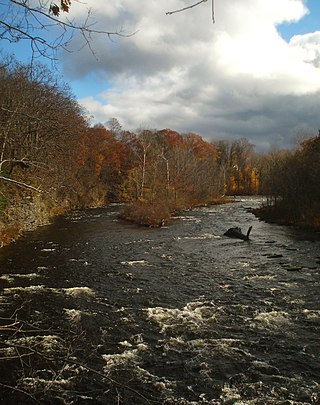
The Allegheny National Fish Hatchery was established by Congress in 1959 to produce rainbow, brook, and brown trout for northwestern Pennsylvania streams. Construction began in the late 1960s. Fish production began on site in 1974.

The Allegheny National Fish Hatchery was established by Congress in 1959 to produce rainbow, brook, and brown trout for northwestern Pennsylvania streams. Construction began in the late 1960s. Fish production began on site in 1974.
The current goal of the facility is to produce lake trout for restoration in Lake Erie and Lake Ontario. Allegheny National Fish Hatchery is the only U.S. hatchery tasked with producing fish for the bi-national effort.
The lake trout, Salvelinus namaycush, is a cold water fish of the charr family. The largest of the trout species, it is a deepwater fish which is a cousin to the familiar and popular brook trout (Salvelinus fontinalis). The lake trout is native to the northeast United States and Canada, and it was once a top predator fish in the Great Lakes. Its numbers have dropped due to the introduction of exotic, non-native species such as the sea lamprey, loss of habitat and historic overharvest.
Annually producing as many as 1.3 million fish in the early 1990s, the hatchery now produces an estimated 660,000 fish for Lake Erie and Lake Ontario. It maintains a broodstock population of approximately 2000 fish. Broodstock are used to produce eggs for Lake Michigan as well as for the Erie and Ontario programs.
Access to the Kinzua Dam tailwater fishing pier, immediately upstream of the hatchery on PA Route 59, is open 24 hours per day at flows of 6,000 cu ft/s (170 m3/s) or less. Access to the fishing pier is closed during winter road conditions.
This article incorporates public domain material from websites or documents of the United States Fish and Wildlife Service.

Trout is a generic common name for numerous species of carnivorous freshwater ray-finned fishes belonging to the genera Oncorhynchus, Salmo and Salvelinus, all of which are members of the subfamily Salmoninae in the family Salmonidae. The word trout is also used for some similar-shaped but non-salmonid fish, such as the spotted seatrout/speckled trout.

The lake trout is a freshwater char living mainly in lakes in northern North America. Other names for it include mackinaw, namaycush,lake char (or charr), touladi, togue, and grey trout. In Lake Superior, it can also be variously known as siscowet, paperbelly and lean. The lake trout is prized both as a game fish and as a food fish. Those caught with dark coloration may be called mud hens.

The brown trout is a European species of salmonid fish that has been widely introduced into suitable environments globally. It includes purely freshwater populations, referred to as the riverine ecotype, Salmo trutta morpha fario, a lacustrine ecotype, S. trutta morpha lacustris, also called the lake trout, and anadromous forms known as the sea trout, S. trutta morpha trutta. The latter migrates to the oceans for much of its life and returns to fresh water only to spawn. Sea trout in Ireland and Great Britain have many regional names: sewin in Wales, finnock in Scotland, peal in the West Country, mort in North West England, and white trout in Ireland.

The rainbow trout is a species of trout native to cold-water tributaries of the Pacific Ocean in Asia and North America. The steelhead is an anadromous (sea-run) form of the coastal rainbow trout(O. m. irideus) or Columbia River redband trout (O. m. gairdneri) that usually returns to freshwater to spawn after living two to three years in the ocean. Freshwater forms that have been introduced into the Great Lakes and migrate into tributaries to spawn are also called steelhead.

The brook trout is a species of freshwater fish in the char genus Salvelinus of the salmon family Salmonidae. It is native to Eastern North America in the United States and Canada, but has been introduced elsewhere in North America, as well as to Iceland, Europe, and Asia. In parts of its range, it is also known as the eastern brook trout, speckled trout, brook charr, squaretail, brookie or mud trout, among others. A potamodromous population in Lake Superior, is known as coaster trout or, simply, as coasters. Anadromous populations which are found in coastal rivers from Long Island to Hudson Bay are sometimes referred to as salters. The brook trout is the state fish of nine U.S. states: Michigan, New Hampshire, New Jersey, New York, North Carolina, Pennsylvania, Vermont, Virginia, and West Virginia, and the Provincial Fish of Nova Scotia in Canada.

The cutthroat trout(Oncorhynchus clarkii) is a fish species of the family Salmonidae native to cold-water tributaries of the Pacific Ocean, Rocky Mountains, and Great Basin in North America. As a member of the genus Oncorhynchus, it is one of the Pacific trout, a group that includes the widely distributed rainbow trout. Cutthroat trout are popular gamefish, especially among anglers who enjoy fly fishing. The common name "cutthroat" refers to the distinctive red coloration on the underside of the lower jaw. The specific name clarkii was given to honor explorer William Clark, coleader of the Lewis and Clark Expedition.

The Salmon River is a small river north of Syracuse in Upstate New York, the United States. It is a popular and economically important sportfishing destination, and the most heavily fished of New York's Lake Ontario tributaries. From its headwaters in the Tug Hill region of New York, it flows 44 miles (71 km) westward through two hydroelectric dams and over the 110-foot (34 m) Salmon River Falls before it empties into eastern Lake Ontario at Port Ontario in Oswego County. The Salmon River watershed drains approximately 280 square miles (730 km2).

The silver trout is an extinct char species or subspecies that inhabited a few waters in New Hampshire in the United States prior to 1939, when a biological survey conducted on the Connecticut watershed by the New Hampshire Fish and Game Department found none.
Broodstock, or broodfish, are a group of mature individuals used in aquaculture for breeding purposes. Broodstock can be a population of animals maintained in captivity as a source of replacement for, or enhancement of, seed and fry numbers. These are generally kept in ponds or tanks in which environmental conditions such as photoperiod, temperature and pH are controlled. Such populations often undergo conditioning to ensure maximum fry output. Broodstock can also be sourced from wild populations where they are harvested and held in maturation tanks before their seed is collected for grow-out to market size or the juveniles returned to the sea to supplement natural populations. This method, however, is subject to environmental conditions and can be unreliable seasonally, or annually. Broodstock management can improve seed quality and number through enhanced gonadal development and fecundity.
The aurora trout, Salvelinus fontinalis timagamiensis, is a variant or subspecies of the brook trout native to two lakes in the Temagami District of Ontario, Canada. The existence of the fish was brought to the attention of the angling world by four American anglers who were taken by Archie King of Latchford, Ontario, into Ontario's Lady Evelyn River system in 1923. Recognizing the fish as different or unique, the anglers took a specimen back to the Carnegie Museum in Pittsburgh, in the United States, where Dr. Arthur W. Henn was asked to identify the fish. He wrote about the fish in 1925 wherein he and Rinckenbach identified it as a distinct species, Salvelinus timagamiensis, but since a seminal re-examination of the material by Sale in 1967, taxonomists now agree the fish is, in a fact, at most a subspecies of the brook trout, named Salvelinus fontinalis timagamiensis. Genetic data has not yet supported its taxonomic distinction.

Lahontan cutthroat trout is the largest subspecies of cutthroat trout, and the state fish of Nevada. It is one of three subspecies of cutthroat trout that are listed as federally threatened.

The splake or slake is a hybrid of two fish species resulting from the crossing of a male brook trout and a female lake trout. The name itself is a portmanteau of speckled trout and lake trout, and may have been used to describe such hybrids as early as the 1880s. Hybrids of the male lake trout with the female brook trout have also been produced, but are not as successful.

Seth Green was an American pioneer in fish farming. He established the first fish hatchery in the United States in the Town of Caledonia, New York. He was also a successful commercial fisherman, operating a large and profitable fish and game market in Rochester, New York, and fishing in Lake Ontario.

The Naugatuck River is a 40.2-mile-long (64.7 km) river in the U.S. state of Connecticut. Its waters carve out the Naugatuck River Valley in the western reaches of the state, flowing generally due south and eventually emptying into the Housatonic River at Derby, Connecticut and thence 11 miles (18 km) to Long Island Sound. The Plume and Atwood Dam in Thomaston, completed in 1960 following the Great Flood of 1955, creates a reservoir on the river and is the last barrier to salmon and trout migrating up from the sea.

The tiger trout is a sterile, intergeneric hybrid of the brown trout and the brook trout. Pronounced vermiculations in the fish's patterning gave rise to its name, evoking the stripes of a tiger. Tiger trout are a rare anomaly in the wild, as the parent species are relatively unrelated, being members of different genera and possessing mismatched numbers of chromosomes. However, specialized hatchery rearing techniques are able to produce tiger trout reliably enough to meet the demands of stocking programs.

A game fish is any species of fish pursued for sport by recreationalists (anglers). The capture of game fish is usually tightly regulated. In comparison, nongame fish are all fish not considered game fish. Game fish may be eaten after being caught, though increasingly anglers are practicing catch-and-release tactics to improve fish populations.
The Neosho National Fish Hatchery is the oldest federal fish hatchery in operation today. It is one of 69 fish hatcheries operated by the US Fish and Wildlife Service. It was established in 1888.

Saratoga National Fish Hatchery is part of the National Fish Hatchery System operated by the United States Fish and Wildlife Service. It is located northeast of Saratoga, Wyoming and, along with the Jackson National Fish Hatchery, is one of two National fish hatcheries operating in Wyoming. Saratoga NHF is primarily a broodstock hatchery; it maintains several healthy adults to produce sperm and eggs and distributes fertilized eggs to production hatcheries throughout the country to be hatched and grown to stockable sizes. It is also one of several organizations to establish a program for breeding Wyoming toads.
The Bellvue-Watson Fish Hatchery is a Colorado Parks and Wildlife cold water fish production facility located near Cache la Poudre River and Watson Lake State Wildlife Area in Larimer County, Colorado. Hatchery staff works to support the raising of approximately 1.5 million sub-catchable trout annually. The Watson Lake Rearing Unit, a division within the hatchery, is responsible for rearing approximately 300,000 catchable trout each year. The hatchery stocks fishing sports in Wellington, Fort Collins, Loveland, Longmont and Jumbo Reservoir near Julesburg and Hale ponds.